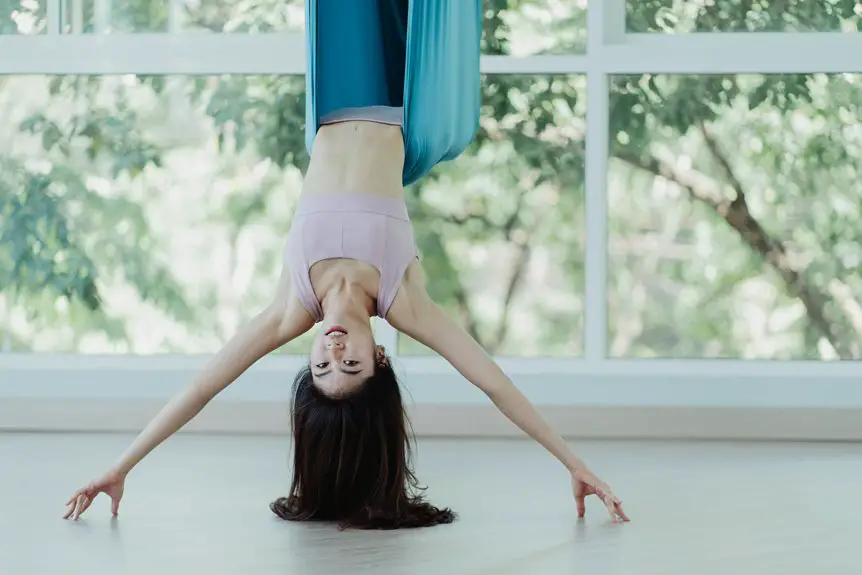Polycotton doesn’t have much natural stretch since it blends cotton and polyester, both fibers that lack significant flexibility on their own. You’ll get softness from cotton and durability from polyester, but the fabric won’t give much unless it includes elastane or spandex. Polycotton’s shape holds up well, resisting shrinkage and wrinkles, making it ideal for comfortable, low-maintenance clothing. If you want to understand how the blend and weave impact stretch and care, there’s more to explore.
Table of Contents
Key Takeaways
- Polycotton blends cotton and polyester, offering limited natural stretch without added elastane or spandex fibers.
- The fabric’s stretch depends on its weave type; tighter weaves restrict movement, while looser or knit-like weaves allow more flexibility.
- Polycotton with standard 65% polyester and 35% cotton has minimal inherent stretch and shape retention without stretch fibers.
- Adding elastane to polycotton significantly enhances stretch, comfort, and recovery after wear and washing.
- Expect polycotton to balance softness and durability but with only slight give unless blended with stretchy fibers.
Understanding Polycotton Composition
Polycotton blends cotton and polyester fibers to combine the best qualities of both materials. When you wear polycotton, you get the breathability and softness of cotton alongside the durability and wrinkle resistance of polyester.
Typically, the fabric consists of around 65% polyester and 35% cotton, but these ratios can vary. This mix helps polycotton hold its shape better than pure cotton, making it less prone to shrinking.
Polycotton’s typical 65/35 polyester-cotton blend enhances shape retention and reduces shrinking compared to pure cotton.
You’ll find polycotton in shirts, bed linens, and uniforms because it balances comfort with easy care. Understanding this fiber blend gives you a clearer idea of what to expect—softness without sacrificing strength or longevity.
This composition also influences how the fabric behaves under different conditions, so knowing it helps you make smarter fabric choices.
How Fiber Blends Affect Stretch
Although stretchiness often depends on fabric structure, the blend of fibers plays an essential role in how much a material can stretch and recover.
When you look at polycotton, the ratio of polyester to cotton directly impacts its elasticity. Polyester adds strength and shape retention but isn’t naturally stretchy, while cotton offers softness and some flexibility.
If your polycotton fabric has a higher polyester content, expect less stretch but better durability. On the other hand, more cotton means a bit more give, but the fabric might lose shape over time.
Keep in mind, neither fiber inherently provides significant stretch without added elastane or spandex.
Comparing Polycotton to Pure Cotton Stretchiness
When you compare the stretchiness of pure cotton to a polycotton blend, you’ll notice some key differences in how each fabric responds to movement.
Pure cotton tends to have a natural softness but limited stretch, meaning it won’t flex much when you move. It’s comfortable but can feel restrictive if the garment isn’t designed with extra room.
On the other hand, polycotton blends offer a bit more give. While they don’t stretch like spandex or elastane fabrics, the combination of fibers allows for slight flexibility that helps the fabric recover its shape better after stretching.
The Role of Polyester in Fabric Flexibility
Understanding why polycotton offers more flexibility than pure cotton means looking closely at polyester’s contribution.
Polyester fibers are inherently stronger and more elastic than cotton fibers. When blended, polyester adds resilience to the fabric, allowing it to bend and stretch slightly without losing shape.
You’ll notice that polyester’s synthetic structure lets the fabric recover quickly after movement, reducing sagging or wrinkling. This flexibility makes polycotton more durable and comfortable for active wear or garments needing a bit of give.
While polyester doesn’t create as much stretch as spandex, it does improve overall fabric performance by balancing cotton’s softness with enhanced flexibility.
Does Polycotton Stretch Naturally?
You might wonder if polycotton stretches on its own.
The fiber blend, along with the fabric’s weave, plays a big role in how flexible it feels.
Understanding these factors helps you know what to expect from this popular fabric.
Fiber Composition Impact
Although polycotton blends combine natural and synthetic fibers, they don’t inherently stretch much on their own.
The cotton in polycotton offers breathability and softness but lacks significant elasticity.
Polyester adds durability and wrinkle resistance but doesn’t contribute much to stretch either.
Since neither fiber is naturally elastic like spandex or elastane, your polycotton garments won’t provide much give unless those stretchy fibers are added.
The ratio of cotton to polyester also matters—a higher polyester content might make the fabric feel slightly firmer but won’t increase stretch.
So, if you want polycotton with stretch, you need to look for blends that specifically include elastic fibers.
Otherwise, expect limited natural stretch from the fiber composition alone.
Weave and Stretch
Even if the fibers themselves don’t stretch much, the way polycotton is woven can affect how much movement the fabric allows. You’ll find that different weaves create varying levels of natural stretch and flexibility, even without added elastic fibers.
For example, tighter weaves tend to restrict movement, while looser weaves offer more give. When choosing polycotton, consider how the weave impacts comfort and fit.
Keep these weave factors in mind:
- Plain weave: minimal stretch, firm structure
- Twill weave: moderate flexibility, diagonal pattern
- Satin weave: smooth surface, limited stretch
- Knit-like weave: more natural stretch, softer feel
- Weave density: tighter weaves reduce stretch, looser weaves increase it
Understanding the weave helps you predict how much natural stretch polycotton will provide.
Blended Fabric Flexibility
While polycotton blends combine polyester and cotton fibers, the fabric’s natural stretch depends largely on the fiber composition and construction.
Polyester itself has minimal inherent stretch, and cotton is mostly inelastic. So, polycotton won’t stretch much unless it’s woven with a specific knit or combined with elastic fibers like spandex.
If your polycotton fabric is a tight weave, expect limited flexibility. However, when blended thoughtfully, it can offer moderate give, making it comfortable for everyday wear without losing shape.
In short, polycotton doesn’t stretch naturally like knit fabrics but can have some flexibility depending on how it’s made.
Always check the fabric details if stretch is important for your project or clothing needs.
Influence of Weave and Knit on Polycotton Stretch
You’ll notice that the type of weave plays a big role in how much polycotton stretches.
Different knit patterns also change the fabric’s flexibility and recovery.
Let’s explore how these factors shape the overall stretch properties.
Weave Types Impact
Because the weave or knit structure shapes the fabric’s flexibility, it directly affects how much polycotton stretches. Different weave types create varying levels of stretch and recovery in polycotton.
For example, tighter weaves limit stretch, while looser weaves allow more give. Understanding these differences helps you choose the right polycotton fabric for your needs.
Here’s how common weave types impact polycotton stretch:
- Plain weave: Minimal stretch, very stable and durable
- Twill weave: Moderate stretch, diagonal pattern adds flexibility
- Satin weave: Slight stretch, smooth surface but less stable
- Basket weave: More stretch due to its looser structure
- Herringbone weave: Similar to twill, offers moderate stretch with texture
Knowing these will help you pick polycotton fabrics with the right balance of comfort and durability.
Knit Patterns Effect
The way polycotton stretches doesn’t just depend on the weave type; knit patterns play a significant role too.
When you choose polycotton with a knit construction, you’ll notice more natural stretch because knit fabrics consist of interlocking loops, allowing the fabric to expand and contract.
Jersey knits, common in t-shirts, offer moderate stretch and good recovery, making them comfortable for casual wear.
Rib knits provide even more elasticity, thanks to their vertical ribbing, which can stretch extensively without losing shape.
On the other hand, polycotton blends in woven fabrics won’t stretch much unless they include spandex.
Adding Elastane to Polycotton for Extra Stretch
Adding just a small percentage of elastane to polycotton can dramatically boost its stretch and recovery. When you choose polycotton blended with elastane, you get a fabric that feels more flexible and comfortable without losing durability.
This addition allows the fabric to return to its original shape after stretching, which is perfect for activewear and fitted garments.
Here’s what you can expect when elastane is added to polycotton:
- Enhanced stretchiness for greater freedom of movement
- Improved shape retention after wear and washing
- Softer hand feel while maintaining strength
- Reduced wrinkling compared to pure polycotton
- Versatility for various clothing styles, from casual to performance wear
Stretch Testing Methods for Polycotton Fabrics
When you select polycotton with elastane for its stretch benefits, it’s important to understand how manufacturers test that stretch to guarantee quality.
They typically use a stretch testing machine that measures how far the fabric can extend under tension before returning to its original shape. This involves applying a controlled force to the fabric sample and recording its elongation percentage.
You might also find tests measuring recovery rate, which shows how well the fabric bounces back after stretching. Sometimes, manual stretch tests are done by hand to get a quick feel for flexibility.
Knowing these methods helps you trust that the polycotton fabric you choose will perform as expected, offering the right balance of comfort and durability without unwanted sagging or loss of shape over time.
Common Uses of Polycotton Based on Its Stretch
You’ll find polycotton fabrics with stretch used in a variety of applications where comfort and flexibility matter.
Since this fabric combines the breathability of cotton with the durability and slight elasticity of polyester, it’s ideal when you need some give but not full spandex-like stretch.
Combining cotton’s breathability with polyester’s durability, polycotton offers gentle stretch without the full elasticity of spandex.
Here are common uses you might encounter:
- Casual and work shirts that require ease of movement
- Lightweight uniforms for jobs needing comfort and durability
- Bedding like sheets and pillowcases that fit snugly without bunching
- Dresses or skirts that benefit from gentle stretch for shape retention
- Light outerwear or jackets offering comfortable flexibility
When you choose polycotton with stretch, you get practical versatility suitable for daily wear or home essentials without sacrificing comfort.
Caring for Polycotton to Maintain Its Shape
Although polycotton blends offer durability and stretch, proper care is essential to keep their shape intact over time.
You should wash polycotton garments in cold or warm water using a gentle cycle to prevent excessive wear. Avoid using bleach or harsh detergents, as they can weaken fibers and cause fabric distortion.
When drying, opt for low heat or air drying to minimize shrinkage and maintain elasticity. If you use a dryer, remove the items promptly to reduce wrinkles and prevent stretching out.
Iron polycotton on a medium setting while the fabric is slightly damp to restore smoothness without damaging the fibers.
Choosing Polycotton for Comfortable and Durable Clothing
When you choose polycotton, you get the best of both worlds: softness from cotton and strength from polyester.
This blend guarantees your clothes stay comfortable and durable through everyday wear.
Plus, caring for polycotton is simple, helping you maintain its shape and feel over time.
Fabric Blend Benefits
Because polycotton combines the best qualities of both polyester and cotton, it offers a perfect balance of comfort and durability.
When you choose polycotton, you get a fabric that feels soft against your skin yet holds up well through daily wear. This blend resists wrinkles and shrinks less than pure cotton, making your clothes easier to maintain.
Plus, it breathes better than polyester alone, keeping you comfortable in various temperatures. You’ll also appreciate how it handles moisture, drying faster than cotton.
Here are some key fabric blend benefits you’ll enjoy with polycotton:
- Softness and breathability from cotton
- Strength and wrinkle resistance from polyester
- Reduced shrinkage after washing
- Faster drying times
- Enhanced durability for long-lasting wear
Wear and Care
Polycotton’s blend of comfort and durability makes it a smart choice for everyday wear, but how you care for it plays a big role in keeping it looking and feeling great.
You should wash polycotton garments in cold or warm water to prevent shrinking and color fading. Avoid high heat when drying; opt for a low tumble dry or air dry to maintain the fabric’s integrity.
Iron on a medium setting if needed, but check the care label first—some blends resist wrinkles well and need little ironing.
By following these simple steps, you’ll extend the life of your polycotton clothes, keeping them comfortable and durable for daily use.
Proper wear and care guarantee you get the best performance from this versatile fabric.
Frequently Asked Questions
Is Polycotton Fabric Hypoallergenic?
Back in the Victorian era, they’d wonder if polycotton’s hypoallergenic. You’ll find it generally gentle on skin, but some might react to synthetic fibers. So, don’t assume it’s perfect if you’re super sensitive, alright?
How Does Polycotton Handle Moisture and Sweat?
You’ll find polycotton blends wick moisture better than pure cotton, but they’re not as breathable. They handle sweat decently, drying faster, yet you might still feel some dampness during intense activities or hot weather.
Can Polycotton Be Easily Dyed or Printed On?
Dyeing polycotton is like painting on a canvas; you’ll find it takes color well but not as vividly as pure cotton. You can print on it easily, but the synthetic blend may slightly dull some shades.
What Environmental Impact Does Polycotton Production Have?
You should know polycotton production uses synthetic fibers, which involve fossil fuels and chemicals, increasing pollution. Its cotton part requires water and pesticides. Overall, it has a higher environmental impact than pure natural fabrics.
Is Polycotton Suitable for Sensitive Skin?
Sensitive skin? Sure! Polycotton’s soft, smooth surface soothes, but some synthetic spots might spark slight irritation. You’ll want to wash it well and test a small patch before fully trusting this fabric’s friendly feel.
- The Use of Nonwovens in Construction and Civil Engineering - July 11, 2025
- The Use of Nonwovens in Construction and Civil Engineering - July 11, 2025
- The Use of Nonwovens in Construction and Civil Engineering - July 11, 2025







